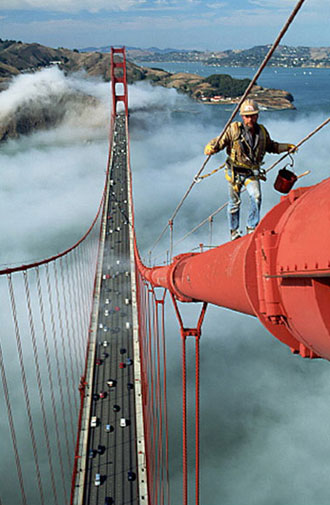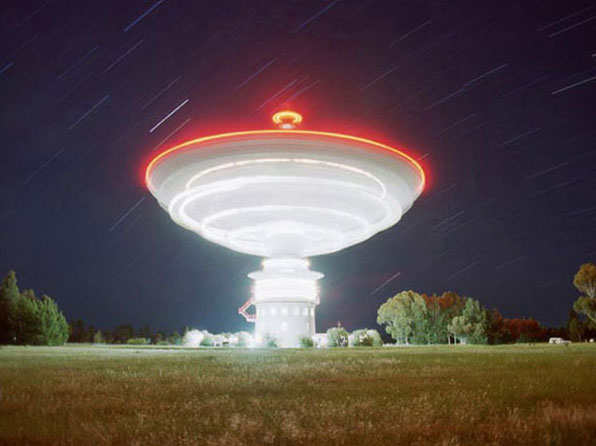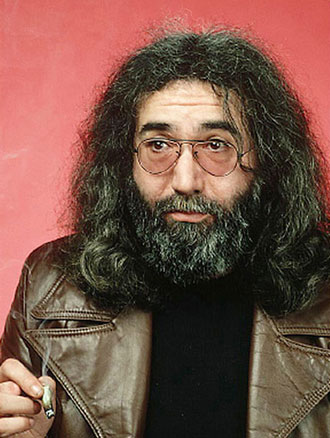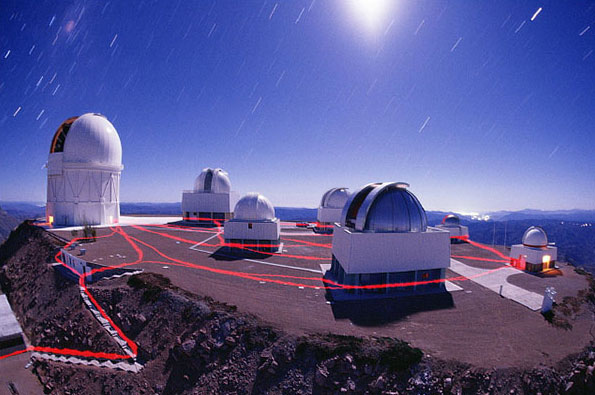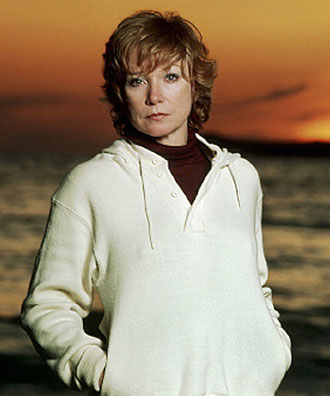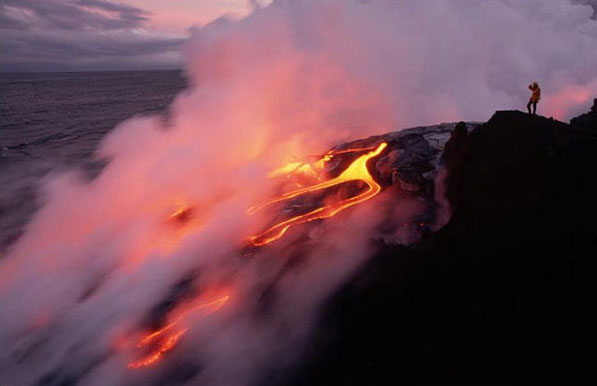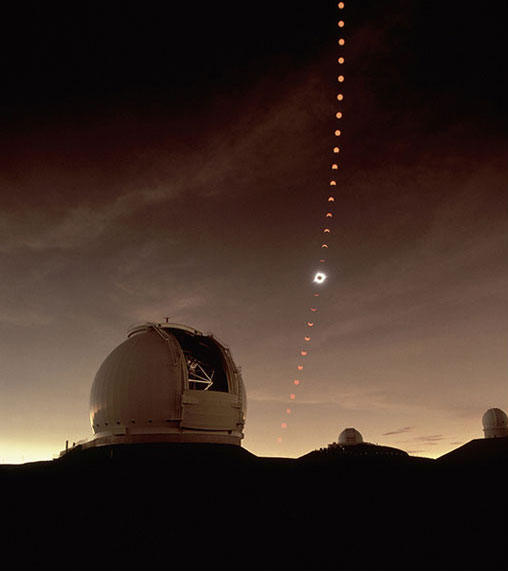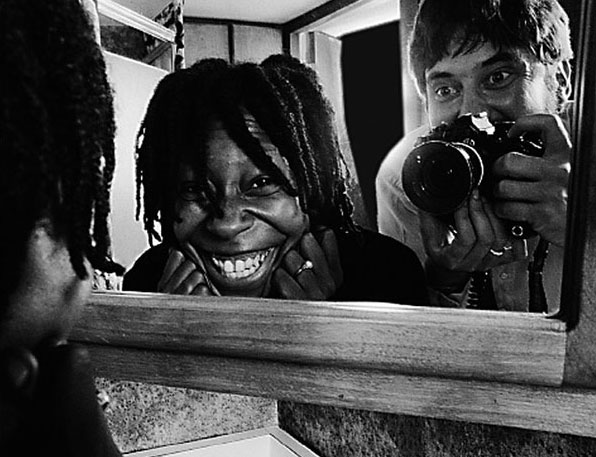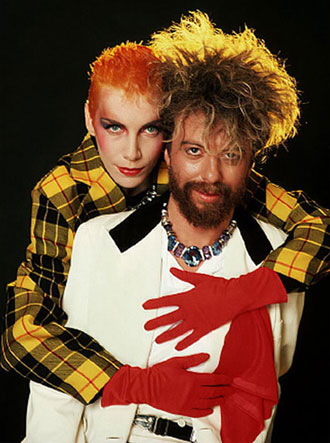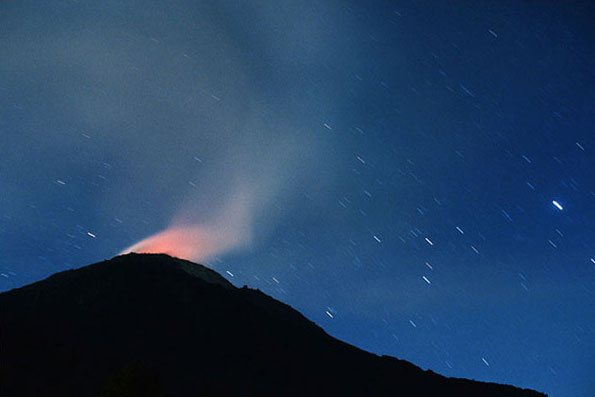|
From PHOTOWORKSHOP.COM Photos to Inspire
Beginning with his days as a zany rock n' roll photographer--to becoming a celebrity shooter, astro photographer, and top stock agency executive--Roger Ressmeyer's career has evolved in a very intriguing way. It all began in the San Francisco Bay Area during the mid-70s when, donned with a flash helmet of his own invention, he became the official photographer for Grace Slick and Jefferson Starship. From there, he expanded his repertoire to include celebrities, writers, politicians and other notable subjects. And because his first love has always been outer space, he started a stock agency during the '80s called Starlight, which encompassed both his photography of Hollywood luminaries as well as stars in far-away galaxies. Eventually he became a top name in space photography and global travel images here on earth, and his work appeared in National Geographic, Smithsonian, Science Digest, Newsweek and LIFE, among other top publications. Today, he is CEO of his own stock agency, Science Faction, which is distributed by Getty Images. "When I was eight years old, John Glenn was launched into orbit," Roger Ressmeyer recalls. "I became an instant space fanatic, and was obsessed with our place in the universe." From age 8 through 15 he read everything he could about space, and built telescopes and telescope mirrors from scratch. And because he discovered that a telescope is just a camera lens, at the ripe age of 11, Ressmeyer bought a used SLR camera body and began learning photography. He learned about time exposures, clock-driven telescope mounts, and cable releases. "I started out being interested in the extreme forms of photography," he says. "I remember as a child, my first camera was a Kodak Instamatic purchased at the New York World's Fair in 1964." He shot 3 or 4 rolls of film with it, then took it apart and modified the shutter by hand so that the simple, plastic camera was capable of time exposures.
Overcoming Challenges Early on, Ressmeyer became a fan of LIFE and National Geographic. He also recalls that 1967 was a profound year for him: "In January, the Apollo One fire took place, and for a certain period of time, no one was certain whether we would ever get to the moon." And then during that summer ("the summer of love"), he fell in love with vocalist Grace Slick, who he describes as "his teen dream rock star,"--and whom he would photograph one day. It was also the year that Ressmeyer was diagnosed with diabetes. "Getting diabetes at age 13 gave me something to overcome," he remembers. "But it also meant that I couldn't be an astronaut." He went through a brief period of depression when he wanted to keep his illness a secret. "The camera became a way for me to be around people and not have to talk about myself, or say much of anything at all." Out of concern, a teacher loaned him a 35mm Nikon camera with a couple of lenses, and he became the yearbook photographer in ninth grade. After graduating from high school, he entered Yale on a four-year special program in astronomy, but realized about a year into it that he didn't really like calculus and physics. He did, however, enjoy being at the observatories and experiencing the vastness of space. He switched gears and studied group dynamics and institutional psychology. "The program I was in gave me a huge boost ahead as a 21-year-old," Ressmeyer notes. "I learned how to crash through boundaries, and learned how to separate my own feelings from those that were being placed onto me by the situation." He says that this enabled him to avoid being put off by difficult people, and to resist group pressure from those who tried to talk him out of becoming a photographer.
Bay Area Music Days In 1976, he invented the "flash helmet" after assisting Norman Seeff, a famous Hollywood photographer who photographed album covers for top musicians like Carly Simon and the Rolling Stones. "He always lit his photos with an umbrella strobe over his head that was held by an assistant," Ressmeyer explains. Since he couldn't afford an assistant or expensive strobe lights, he invested in the revolutionary new Vivitar 283 on-camera flash with built-in flash exposure, which had a detachable sensor and a remote cord. "I plugged the sensor into the hot shoe of my 35mm camera, and put the flash on a helmet on my head pointing backwards into an umbrella," he says. "So now I had an automated assistant on my head, which allowed me to get much closer to people with soft, broad lighting. It was also bizarre, so it made people get loose." Ressmeyer's first flash helmet photo subject was Grace Slick, who recently used one of the images from that shoot for the cover of her autobiography, Somebody to Love. Word has it that the flash helmet was even parodied on Saturday Night Live. At around this time, Ressmeyer met Jerry Rubin of the Chicago Seven, and did a few photo sessions with him. "What photographers have to do when they're unknown is that without lying, they have to present the truth in a most positive way," he laughs. "I told Grace that I was Jerry Rubin's photographer, and I told Rubin that I was Grace's photographer, and that helped cement the deal with both of them." Photos from his first assignment photographing Jefferson Starship at a concert in Golden Gate Park appeared on the back of their album covers. "I had an interest in the group years before they actually hit big," he says. "I was with them from the beginning." Starship became Ressmeyer's most important client, and his pictures of the band appeared in Rolling Stone, Newsweek, and other publications. He began pounding the pavement in New York, by calling these magazines and letting them know they had just published his pictures of Paul Kantner and Grace Slick. "I'd say, why don't I come see you; I'm only here for a few days." Meanwhile Starship started introducing him to other bands. He says, "There was a vacuum at that time in San Francisco that I walked into." There was no space program in 1975, he recalls, "but Starship did space rock. So I took a diversion into space-age space music."
Luminaries From 1975 through the mid-80s, he photographed mostly celebrities for magazines like People, Rolling Stone, and TIME. During this time, he shot over 200 stories for People magazine, "which really paid the rent." In addition to Starship, Ressmeyer photographed the Doobie Brothers, the Eagles, Huey Lewis & the News, the Grateful Dead, and all the major rock bands on the west coast. "Merle Haggard was another one of my flash helmet shots that I was most proud of," he exclaims. "I started out with one camera, three lenses, about $1000 in the bank, and no work," he says. "I put every bit of money I made back into the career. With every job, I would go out and buy a Dyna-Lite strobe or lenses." He was also one of the first photographers who began using strobe lights at almost every magazine shoot, which upped the ante with his clients. Ressmeyer began shooting front and back covers for Bantam Books, and became known as the guy who "could photograph difficult people who were difficult to photograph." He shot 18 jacket photos for Danielle Steele's books, and photographed Shirley Maclaine for the cover of her bestseller, Out on a Limb.
All this time, his love of space photography remained. He photographed a solar eclipse in 1979, and continued to develop his lighting techniques and time exposures. "I have always been blessed with all the right contacts at the right time," observes Ressmeyer. After meeting Scott DeGarmo, the editor-in-chief of Science Digest and later Success, Ressmeyer wrote and photographed a story for the magazine on new telescopes for amateurs. "One-third of my business was the free-thinkers of the writing and artistic world, one-third was more highly lit business photography, and one-third was a constant push to get into space photography." Breaking into the Space Market When he met DeGarmo at Science Digest, the magazine was new and very visual, and Ressmeyer suggested that he photograph astronauts for them. To his surprise, DeGarmo gave him the go-ahead. "For two or three years, Science Digest gave me free reign to shoot stories I was interested in, and assignments on hot new science stories." This gave him the opportunity to use his remote-control and telescope-driven photography on rocket launches. He had also studied a lot about compositing images optically, as well as other special effects. Before the first space shuttle launch, he says, there was a lot of anxiety at NASA. The space shuttle was an entirely new vehicle, a rocket/aircraft that would be flown at full speed with astronauts aboard on its first flight. Ressmeyer went to Houston, spent a few weeks "hanging out in the simulators," and worked with a successful writer who was trying to break into the space market. He also met Lisa Vazquez, who helped run the NASA picture library (she has since worked for Ressmeyer). As he traveled more extensively for space photography, his diabetes became more of an issue. One close call came just after the first space shuttle launch. "I arrived without an assistant and it was too late to get a hotel room at the Cape. I was basically not sleeping for days on end," he says. The launch was delayed for 24 hours, and he had to get up at 4 a.m. to go to the site.
The shuttle took off, but Ressmeyer and other photographers were delayed for several hours after news broke that tiles were missing on the shuttle. NASA searched meticulously around all the camera equipment for tiles or anything that had broken off the shuttle during the launch. Ressmeyer had taken time-release NPH insulin several hours previously, "which is what you did in those days," and apparently went into insulin shock. "I woke up in the driver's seat of my car several hours later with a half-empty bottle of orange juice between my legs, parked in the nearest deli to the Cape," he remembers. In front of him was a newspaper rack, and photos of the shuttle going up were already headline news. He realized he had lost a few hours, but somehow in a coma, had managed to drive his car and get the orange juice that he needed. "That was the call for action for me for closer monitoring," he says. After this first shuttle launch, at-home, portable blood-glucose monitoring became available. Ressmeyer credits this medical breakthrough with his continuing work. "Without it, my career of global travel, mountain climbing, nighttime and around-the-clock photography would have been impossible." To this day, he hasn't suffered from a single sign of diabetic complications, even while living the life of a world explorer carrying around up to 800 lbs. of camera, lighting and special-effects gear. All the while, Ressmeyer was photographing celebrities and pushing his space photography forward. He met a publisher who was willing to do a calendar based on his space photographs. "They published the calendar and I got a couple hundred extra copies," he says. "It became my first major marketing piece. As the months changed, I would invariably get requests for that month's photo for stock purposes." Three or four years in a row, Ressmeyer did a space calendar, which cemented his name in the minds of many photo editors. He began to get more space photography assignments, and became known as someone who could light anything, and take the most mundane subject and make it look interesting.
During the '80s, when President Reagan announced the Star Wars program, Ressmeyer suddenly became the photographer of choice that people called to photograph all the national labs, as well as emerging technology. His stock business grew, and he started his own agency. "In 1982, I selected the name Starlight. It was about stars--celebrities and outer space." During this time, he had approached National Geographic and the photo editor was very dismissive. "He asked jarring questions, like 'what makes you think you're ever going to be a good photographer?' I felt as though there was no chance in the universe I would ever work for them." At Smithsonian, he met a woman named Caroline Despard, who was the director of photography. While she liked some of his work, she commented that he hadn't done enough "big, in-depth stories," and suggested that he come back in five years. "That was crushing too," he says. "But being dogged, determined and having all this experience in group dynamics, I continued to develop work with other publications." Exactly five years later, he went back to Despard's office at Smithsonian, and walked out with a cover story assignment on electrical power. Shortly thereafter, he got an assignment from Smithsonian that he had always wanted, whereby he was given the opportunity to photograph telescopes. This assignment took him to Mauna Kea on the big island of Hawaii and the Palomar telescope in southern California. And because of his work as an amateur astronomer, he had special access to a technique that astronomers had been using for years. "I had a special trick up my sleeve called hyper-sensitized film," he says. Sensitizing film involved putting it in a vacuum chamber, purging all oxygen, removing the emulsion's humidity by soaking the film in nitrogen gas, and then baking it at high temperatures for 24 hours or more in hydrogen forming gas, and--thus decreasing reciprocity failure. Jack Marling, who perfected the hypering of film for amateur astronomers, took Ressmeyer under his wing and taught him many other aspects of deep-space astrophotography. He used this film from 1980-95, and the average photographer didn't have access to it.
Putting People in Space "I became a camera tech addict," says Ressmeyer. "Much of my equipment was home built, or manufactured to my specifications." He often mixed people into his special effects photography, such as the time he photographed Shirley Maclaine for her book, Dancing in the Light. He took a strobe shot of her in a totally dark room, and then with strobe lights flashing behind a black seamless paper that had holes punched in it, he zoomed his lens to create the illusion of stars swirling around her head. Ressmeyer also shot the first images of nuclear fusion. "You couldn't see the results of the pictures right away," he says, although he shot Polaroids to get some idea of the exposures. "I became this guy who would take humongous risks, but could seemingly pull a rabbit out of any hat." He was called in to photograph media executive Rupert Murdoch at the New York Post, so Ressmeyer flew to New York, where he set up three different locations and lit them well ahead of the shoot. "It was a situation where we were only given 10 minutes," he says. When Murdoch arrived, I was able to move him from set to set." At the Post, Ressmeyer asked the employees to stop the press so that Murdoch could stand under the rollers safely. Then he photographed Murdoch standing amid the press machines with the rolls of paper all around him, reading the Post. One of the resulting images was re-published over a hundred times. Ressmeyer was one of the candidates to be the first journalist in space in 1986. "I had developed a plan from within the space shuttle to dim the lights, light-paint the astronauts, and let the view outside the window burn in with a re-focused time exposure so that you could put the astronauts in the context of the universe," he says. But once again he wasn't chosen to go into space. On what would be perhaps the greatest tragedy in a shuttle launch, President Reagan decided to send a teacher instead. The Challenger explosion shortly after liftoff remains one of the most traumatic events in the history of the space program.
Longtime Dream Realized In 1987, suddenly National Geographic began calling him. "It was a dream come true," Ressmeyer says, particularly after he had been discouraged by the photo editor years earlier. But unbeknownst to him, Tom Kennedy and Rich Clarkson, the new, younger Geographic photo editors had been following his work for some time. His first assignment--a more in-depth telescope story--marked another breakthrough for him. "In 1987, the brightest supernova (exploding star) occurred in about 500 years," he says, and he was sent to the greatest observatories in the world. He had the opportunity to execute some great special effects when shooting the supernova story. Ressmeyer did a multiple exposure on one frame of film, showing the man who had discovered the bursting star with the universe, Milky Way galaxy and Supernova 1987avisible in the sky above the telescope used for the discovery. This image was the opening for the Geographic story in May 1988, entitled "Supernova--Death of a Star." It also became the cover of Ressmeyer's book, Space Places, which was published in 1990. "The supernova story, along with an earlier Smithsonian assignment, were the germs that created this book," he explains. Among his other memorable assignments for National Geographic was a story on the great solar eclipse of 1990, which he describes as "the greatest eclipse of the century." This story took a lot of advance planning and clearance, and as he puts it, "It was far and away my favorite shoot." Other notable assignments include "Mission to Mars" in '88, which appeared in the 100 year anniversary issue of Geographic; "Volcanos: Crucibles of Creation" in '92; "The Universe" in '94, and "A Comeback to Nuclear Power." In 1995, Ressmeyer sold his photo archive to Corbis--it was the first-ever, seven-figure outright acquisition of a living photographer's body of work at the award-winning peak of his/her career.
Training Astronauts Around this time, a Harvard astonomer referred a brilliant astronaut named Jay Apt to Ressmeyer. Apt asked him to train NASA astronauts to shoot better pictures while in orbit. "It was sort of a tough decision," Ressmeyer says, "because saying yes meant I could no longer believe that I would go into orbit to be a journalist. But what do you say--this guy was the non-diabetic version of myself." So he went to Houston, and under the auspices of NASA, he trained a number of their most important astronauts, including Bill Readdy and Frank Culbertson. His friendship with Jay Apt resulted in the best-selling book, Orbit, published by National Geographic in 1996, which was also the magazine's cover story. NASA gave Apt and Ressmeyer an exclusive contract to scan the astronaut's original flight film taken in space. Ressmeyer got letters from the NASA administrator, thanking him for training Apt when he went on his mission, as the images were better than anything NASA had ever seen in orbit. In 1996, they created 100-megabyte scans of the best 600 images. "I used Apt and some of his friends as color checkers," he says. Corporate Executive Ressmeyer's new stock agency, Science Faction Images, is distributed by Getty Images, with whom he was an executive for four years. During his tenure at Getty, he achieved some big successes for photographers with programs that he developed, such as "Photographer's Choice," a new brand for which photographers select the images they want to put on the site, instead of having images selected only by a Getty editor. "Photographer's Choice has been a great program for the company as well as the photographer," he notes, "especially in cases when the photographer has invested in a shoot at their own expense for the company. It also gives Getty a second windsock of information about what's selling." Although he held several executive positions with Getty, the one that sums everything up was that of Vice President of Strategy and Corporate Development. He helped Nick Evans-Lombe develop their third party brand program with image partners, and other developments. "It was a good run," he states. Ressmeyer left Getty to go to a startup company called Gallery Player, where he was Vice President of Content and Creative Direction. "They were trying to fulfill Bill Gates' original dream of art for the walls," he says. "Why not turn your big black TV box into a beautiful rear-screen projector slideshow?" When I comment on his great diversity throughout his career, he responds, "Part of it was driven by my diabetes. I was told I had just 20 years to live back when I was 13. When the 20-year anniversary passed in '87, I started to take life much more seriously."
In 2004, he took time off after Gallery Player "to figure out what I wanted to be when I grew up." After considering several business plans, Ressmeyer decided to go back to his roots. "The problem with working in business development for these companies was that I wasn't shooting very much, or even working with images by other great photographers" he says. Thus, Science Faction Images was born in January 2005. "It was the only time when Getty gave a contract to somebody when they didn't even have a collection of images yet." He says he gets a great deal of satisfaction from shooting again. He also represents other top photographers at his stock agency, which he describes as "the digital version of Starlight. We have about 30 photographers and seven photo agencies whose work we distribute." What makes Science Faction unique, says Ressmeyer, is that they specialize in high-end science photography. "I believe that freelancers are the most creative," he continues, "because they own their own work, and they care more about how it looks. Freelancers usually squeeze out a few more hours of energy each day." When asked whether he still hoped to get into outer space one day, he replies, "Of course! I have two choices--I can either rob a bank and come up with 20 million dollars, or wait for the next space age, which is finally coming with the Constellation/Orion program." Learn more about Roger Ressmeyer and his work. © Copyright by PHOTOWORKSHOP.COM |
